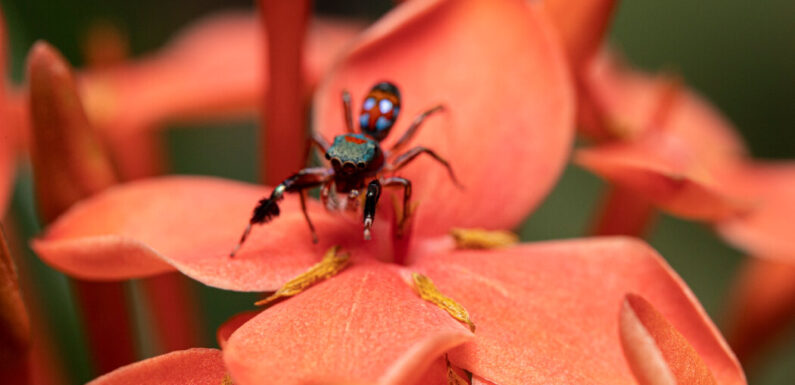
Siler collingwoodi is a spider that jumps and wears a coat of vibrant and metallic blues, oranges and sometimes reds. It also does impressions, copying the movements of an assortment of ant species.
The jumping spider doesn’t mimic ants for attention — rather, the opposite. Ants are aggressively territorial and are known in the insect world for their deadly jaws and their use of venom and other defensive strategies. Hundreds of spider species imitate ants to avoid being eaten by predators.
But colorful S. collingwoodi does something distinctive among mimics. Researchers have found that the jumping spider imitates certain features of multiple ant species in its habitat. By looking like — but not perfectly imitating — the ants, this makes it what the researchers call an imperfect mimic. But that imperfection is enough to fool one of the jumping spider’s most dangerous predators.
The researchers also found that the spiders may find another layer of protection by blending into a similarly brilliant plant in their habitat. The findings were published Wednesday in iScience.
When it comes to scaring off a predator, many species attempt “perfect” mimicry because, in theory, appearing nearly identical to something scary would make the chances of survival more likely.
“Most studies in mimicry in spiders have been focused on the perfect mimics,” said Hua Zeng, a behavioral scientist at Peking University in China and an author of the study. “However, there are also many imperfect mimics, which deserve investigation in terms of their ecological significance.”
While in the field, Dr. Zeng and colleagues noticed that the S. collingwoodi displayed walking patterns similar to those of ants. The spiders would even occasionally hold up their first pair of legs in a way that looked like an ant holding up its antennae.
The researchers theorized that S. collingwoodi could be adopting the movements of more than one ant species, giving itself more tactics to protect itself from predators, said Wei Zhang, another author of the study and an evolutionary biologist also at Peking University. The jumping spider may even be able to expand its habitat this way.
To test this idea, the researchers collected S. collingwoodi, a non-mimicking jumping spider and five ant species from locations on Hainan Island in southern China. Back in the lab, they compared the movement of the ants and spiders and found that S. collingwoodi not only displayed pseudo antennae and bobbed its abdomen like an ant, but also showed a similar gait, pattern of movement and speed to many of the ants as it walked. The other spider did not show these similarities.
The researchers then put the S. collingwoodi’s proposed imperfect mimicry to the test with two of its predators: a mantid species and another jumping spider, Portia labiata. For the mantid, both spiders were fair game. But the predatory spider avoided S. collingwoodi and only launched attacks toward the non-mimetic spider, which the researchers interpreted as a sign that ant mimicry worked in some cases.
They also showed that predatory P. labiata would attack an injured S. collingwoodi that was unable to mimic an ant. But in that case there is an alternative explanation. Perhaps, said Ximena Nelson at the University of Canterbury in New Zealand, who was not involved in the study, the S. collingwoodi’s predator “simply classified the impaired animals as precisely that: impaired and potentially easier prey.”
Beyond providing a better understanding of imperfect mimicry itself, work like this is important for conservation, said Marta Skowron Volponi, a biologist at the University of Florence in Italy who was not involved in the research.
“The interaction between species is important to study in order to understand how entire ecosystems function,” Dr. Skowron Volponi said. “In order to protect a prey species that is endangered, we should protect everything that is connected with it — the predator, the model and the habitat in which it occurs.”
Source: Read Full Article
